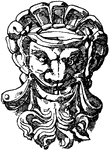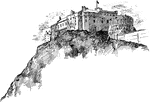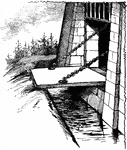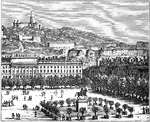
The City of Lyons, France
Lyons-la-Forêt is a commune in the Eure department in Normandy, in northern France. Because of…

William of Wykeham
William of Wykeham (1320 – 27 September 1404) was Bishop of Winchester, Chancellor of England, founder…

Henry V of England
Henry V (16 September 1386 – 31 August 1422) was one of the most significant English warrior kings…
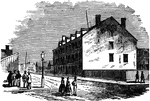
Castle Thunder
Castle Thunder, located in Richmond, Virginia, was a former tobacco warehouse located on Tobacco Row,…
Hampton Court, 17th Century
Hampton Court Palace is a former royal palace in the London Borough of Richmond upon Thames, south west…

Fairfax Taking Possession of Cochester
In 1189, Colchester was granted its first Royal Charter by King Richard I (Richard the Lionheart.) In…

Procession to the Tower of London
Her Majesty's Royal Palace and Fortress, more commonly known as the Tower of London (and historically…

Traitor's Gate, Tower of London
The name Traitors' Gate has been used since the early seventeenth century, prisoners were brought by…
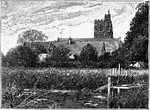
Bray Church, Near Maidenhead, Berks
The Church of England parish church of St Michael was built in 1293, supposedly to replace a Saxon church…

Castle Garden
An illustration of Castle Garden, known today as Castle Clinton or Fort Clinton. Castle Clinton or Fort…
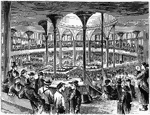
Castle Garden (Interior)
An illustration of the interior of Castle Garden, known today as Castle Clinton or Fort Clinton. Castle…
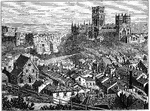
Durham Cathedral and Castle
The Cathedral Church of Christ, Blessed Mary the Virgin and St Cuthbert of Durham, commonly referred…

Harlech Castle
Harlech Castle, located in Harlech, Gwynedd, Wales, is a concentric castle, constructed atop a cliff…

Decorative Mirror Case
An illustration of a decorative mirror case depicting the storming of the castle of Love.

Plan of Durham Cathedral
The Cathedral Church of Christ, Blessed Mary the Virgin and St. Cuthbert of Durham, commonly referred…
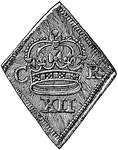
Newark Siege Piece - Obverse
"A coin, generally of unusual shape and rude workmanship, issued in a town or castle during a siege,…
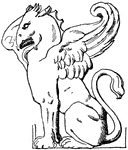
Sitting Griffin
The Sitting Griffin is used as a support of a seat in the Castle of Gaillon during the French Renaissance.

Castle at Blois Dolphin
The Castle at Blois Dolphin is a design found at the Castle in Blois, France during the French Renaissance.
Trophy Door Panel
This trophy door panel was used as a decoration at a castle in Heidelberg, Germany during the German…
Trophy Door Panel
This trophy door panel was used as a decoration at a castle in Heidelberg, Germany during the German…

Evolute Spiral Frieze
The evolute spiral frieze is a wavelike pattern that mimics the waves of the sea. Its interstices (small…

Modern French Cresting Border
This modern french cresting border is a design found in the castle of Pierrefonds in France. It is found…
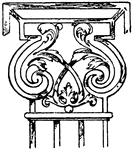
Wrought-Iron Pilaster Capital
This wrought-iron pilaster capital is a 17th century design found in the castle of Athis-Mons, Paris,…

Stone Parapet
The stone parapet is a German Renaissance design of scrolls found on the Dagobert tower, a castle in…

Renaissance Console
The Renaissance console is shaped in front-view like a pendant triangle. This console is found in a…

Renaissance Console
This Renaissance console is a German design found in a castle in Baden-Baden. It imitates the Doric,…
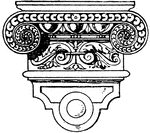
Renaissance Console
This Renaissance console is a German design found in a castle in Baden-Baden. It imitates the Doric,…
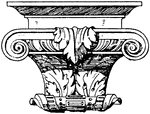
Renaissance Console
This Renaissance console is a German design found in the Heidelberg castle. It imitates the Doric, Ionic…

Renaissance Earring
This Renaissance earring is inspired from a portrait in castle at Gotha in Germany.
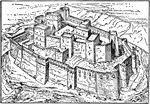
Krak des Chevaliers
Krak des Chevaliers was the headquarters of the Knights Hospitaller during the Crusades. It was expanded…
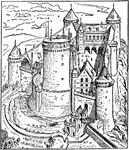
Chateau de Coucy
The Château de Coucy is a French castle in the commune of Coucy-le-Château-Auffrique, in…

Beaumaris Castle
Beaumaris Castle, located in Beaumaris, Anglesey, Wales was built as part of King Edward I's campaign…

Caerphilly Castle
Caerphilly Castle is a Norman castle that dominates the centre of the town of Caerphilly in south Wales.…

Durham Cathedral
An illustration of the floor plan of Durham Cathedral. The Cathedral Church of Christ, Blessed Mary…

Painting Pattern
This painting pattern is a 16th century design found in the Castle of Trausnitz in Landshut, Germany.

16th Century Stoup
This 16th century stoup is found in a chapel of a castle in Mello, France. It is used to store holy…
![William Tyndale (sometimes spelled Tindall or Tyndall; (c. 1494 – 1536) was a 16th-century Protestant reformer and scholar who translated the Bible into the Early Modern English of his day. While a number of partial and complete Old English translations had been made from the seventh century onward, and Middle English translations particularly during the 14th century, Tyndale's was the first English translation to draw directly from Hebrew and Greek texts, and the first to take advantage of the new medium of print, which allowed for its wide distribution (it is worth mention that some scholars claim he made this translation from Latin[citation needed]). In 1535, Tyndale was arrested, jailed in the castle of Vilvoorde outside Brussels for over a year, tried for heresy and burnt at the stake.](https://etc.usf.edu/clipart/62000/62019/62019_w-tyndale_mth.gif)
William Tyndale
William Tyndale (sometimes spelled Tindall or Tyndall; (c. 1494 – 1536) was a 16th-century Protestant…
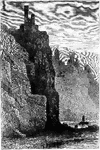
Castle of Neckarsteinach
One of four standing medieval castles in Neckarsteinach, also known as "Vier Burgeneck" because of its…
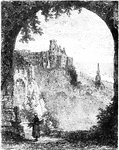
Heidelberg Castle Viewed from Terrace
View of the castle framed by an arch. A landmark of Heidelberg, the castle ruins are among the most…

Interior of Heidelberg Castle
Interior view of Heidelberg Castle with elaborately carved doorway and part of a courtyard.
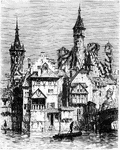
Castle of Unnoth
The Castle of Munnoth, sometimes called Unnoth, was erected in 1564, is a singular specimen of fortification…

Entrance to Heidelberg Castle
A landmark of Heidelberg, the castle ruins are among the most important Renaissance structures north…
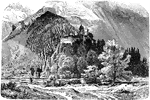
Castle of Hohenaschau
Schloss Hohenaschau, is the dominating feature in the town of Aschau im Chiemgau in Bavaria. The huge…

Falkenstein Castle
Falkenstein Castle or Castrum Pfronten is a High Middle Ages castle ruin in the Bavarian Alps, near…
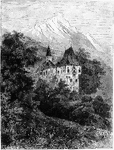
Castle of Weierburg
Weierburg, a fine ancient structure produces such a charming effect that every one asks its name. Though…

Castle of Hohenzollern
The ancestral home of Conrad of Hohenzollern and the third castle constructed on the site. The castle…
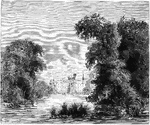
Castle Eisgrub
Eisgrub, now Lednice, a village in the Czech Republic. It contains a palace and the largest park in…

Towers Embattled
"Gules, three towers embattled argent. BATTLEMENTS. Divisions or apertures on the top of castle walls…

Feudal Castle of Rouen
An illustration of the feudal castle of Rouen. Rouen is the historical capital city of Normandy, in…

Portcullis
"PORTCULLIS. A grating suspended by chains, used to defend the entrance to a castle." -Hall, 1862
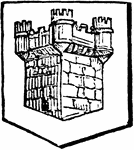
Turreted
"TURRETED. A wall or castle having small turrets. In the annexed example the square tower has circular…

Flag of Gibraltar, 2009
Color flag of Gibraltar. Two horizontal bands of white (top, double width) and red with a three-towered…

Flag of Gibraltar, 2009
Black and white outline flag of Gibraltar. Two horizontal bands of white (top, double width) and red…

Geirrod and Loki
Geirrod the giant spies a bird on the chimney of his castle. It is really Loki wearing Freya's eagle…

